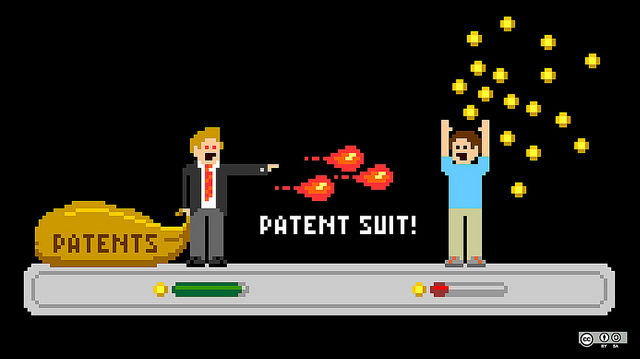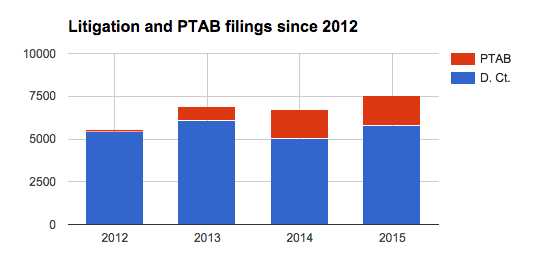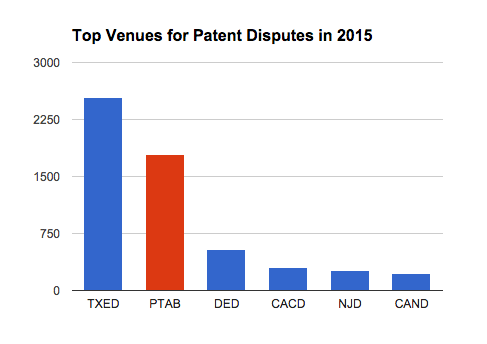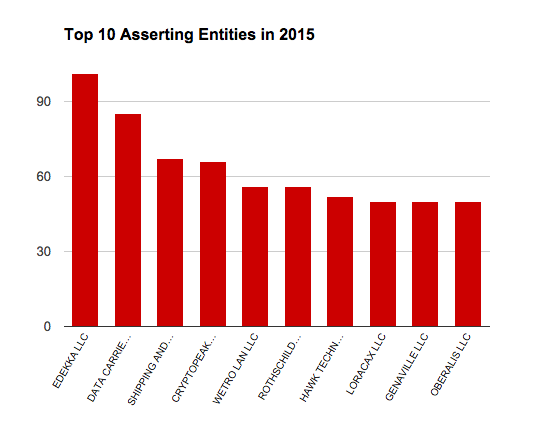
Statistics released today show that 2015 saw more patent lawsuits filed than any other year save one. Buried beneath heaps of high-tech lawsuits—led as usual by "patent trolls," shell companies with no real assets other than patents—are strong trends pushing power away from patent-holders and toward the defendant companies they sue.
If one adds together district court cases with patent disputes that are resolved through the process of "inter partes review," or IPR, a proceeding involving the Patent Trademark and Appeals Board (PTAB) at the US Patent Office, then 2015 saw the most patent disputes in history. If only district court cases are measured, 2013 was the year with the most filings.
"This would indicate that activity has not decreased since the America Invents Act became law," said Kevin Jakel, CEO of United Patents.

Key findings of the United Patents report show that:
About two-thirds (66.9%) of all patent lawsuits were filed by patent trolls, also called "non-practicing entities" or NPEs. That's up from 61 percent last year.
About two-thirds of patent lawsuits are filed in the high-tech sector. Of the high-tech cases, more than 88 percent involved NPEs.
The Eastern District of Texas has vastly more patent disputes than any other district court, and the high numbers are driven by NPE litigation. In the Eastern District of Texas, 95 percent of patent cases are initiated by NPEs. In total, 44 percent of the nation's patent litigation was filed in there. Nearly all of it was assigned to a single judge, Marshall-based US District Judge Rodney Gilstrap.

The NPE business model typically involves settling for less than the cost of litigation, which can run into the millions for a case taken through trial. However, following the Supreme Court's 2014 decision in Alice Corp. v. CLS Bank, it has become much more common for software patents to be thrown out in the earlier stages of a case. That means that the price of beating a bad patent is, potentially, 80 to 90 percent less than it was a few years ago. The chance of getting an award of attorneys' fees has gone up, also thanks to a different 2014 Supreme Court ruling.
The economics of the business has changed, and the 2015 data surely reflects that. Some major players in the "patent troll" world have talked about leaving the patent business, and the top ten most litigious entities from last year are mostly recently created LLCs.
Listed below are 2015's ten most litigious patent entities, most of which are non-practicing entities. Mostly, like eDekka LLC and Cryptopeak Solutions, they concentrate their lawsuits in East Texas. Of the hundreds of lawsuits filed by these 10 NPEs, 72 percent were filed in the Eastern District of Texas. Still, a few, like High Quality Printing Inventions LLC, filed suits across the country using different law firms.

While it's impossible to know exactly what the patent trolls are privately asking for in the thousands of cases they are negotiating over, the data here, combined with anecdotal testimony from attorneys who defend these cases, suggest that the settlements they're asking for are lower than they were a few years ago. At the beginning of the decade, a common strategy for experienced patent asserters was to ask a large company for several hundred thousand dollars—a substantial figure, but less than the few million that a trial would cost, and with no risk of losing. It's possible that the "new breed" of trolls knows it doesn't have much of a chance to win settlements of that size so is settling for less than $100,000—perhaps much less than that. Instead of aiming below the total cost of a litigation, they're aiming near the cost of hiring a lawyer in the first place (which will generally involve a five-figure retainer even to begin a defense.)
The role of inter partes reviews, an increasingly popular method for challenging patents, may also likely be driving down costs.
"It leads to NPEs with questionable patents going for smaller amounts—below the IPR threshold," said United Patents COO Shawn Ambwani. An inter partes review can cost $250,000 to $450,000 through trial, but many IPRs settle at earlier stages at a cost of $100,000 or a bit more, he said. "These NPEs now tend to sue many companies in parallel, since the threat of an IPR causes them to try to get everyone quickly rather than build a track record of settlements."
Lower settlement figures may be leading to a shotgun approach. The size of settlement payments drops, leading patent-holders to go after more targets. It could also encourage lawsuits against smaller companies, who are less able to wage a long legal fight and pursue attorneys' fees.
Whatever the strategy is, many of 2015's patent lawsuits were filed by a handful of attorneys. Five of the top 10 plaintiffs employ just two Texas lawyers: Austin Hansley and Craig Tadlock. (You can't blame it all on the little guys, though—it's worth noting that other NPEs have successfully hired big firms, including Baker Donelson and Mitchell Silberberg & Knupp.)
We still don't have a lot of post-Alice data to know if that's true, but 2016 may show us what's happening, one way or the other.
reader comments
50